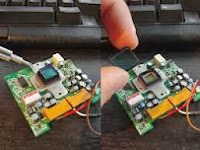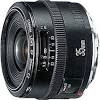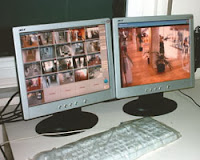Enter Technology
Today’s security professional
is a far different person than the security guard of yesteryear. Gone are the days when padlocks and fences
were sufficient to keep intruders at bay and a guard’s duties consisted of making
patrols and admitting authorized workers with the wave of a hand. The adoption
of IP cameras heralds a new era. At many facilities, guards need a working
knowledge of IP cameras and Video Management Software.
The growing prevalence of IP devices also marks the tearing
down of the wall separating the IT department from the security department. The very fact that IP security system devices reside
on an organization’s local area network (LAN), link the two. And when you come down to it, it's all about catching intruders, whether they're virtual intruders like hackers or phyisical intruders like thieves or terrorists gunmen. So aren’t IT and Security charged with the same tasks - risk management, response, and the ever-present need to
be on guard?
However this doesn’t mean IT and security should require the
same skills. Just because an individual knows how to install a firewall doesn’t
mean she knows how to assess IP camera technology. So more and more we're seeing the responsibility for choosing an IP camera
system to the security department.
“Hiring”
an IP network
Today’s security guard doesn’t work alone. He, or she, has an IP network at his/her fingertips. But when it comes to “populating” that
network some IT / IP savvy comes into play. And that brings us to exactly what security
personnel need to know in the 21st century.
Cameras????
Before a security official can decide on the cameras he
needs, he must determine what he needs to see, or rather how clearly he needs
to see it.
- · Does he just want to detect that an individual is on the premises?
- · Does he need to recognize that individual as a known employee?
- · Or does he need to see a stranger’s facial features for the purpose of forensic identification?
Resolution
In digital imaging, the
smallest element of a picture is called a pixel. Pixels are usually square and
arranged in a two dimensional grid. The resolution of a camera or lens is
usually expressed in terms of the total number of pixels in a frame. An image
with a resolution of 1280 x 1024 is a frame containing a count of 1280 pixels
from left to right and 1024 from top to bottom. Work out the math and we have a
frame composed of 1,310,000 pixels. And since every 1,000,000 pixels is expressed
as 1 megapixel. We are looking at a resolution of 1.3 megapixels.
- If the purpose is mere detection of the person with no notice given to his facial featureschoice should be a camera that supplies at least 5 pixels/foot.
- If the purpose is to recognize an employee or a known visitor, since the mind tends to “connect the dots” when it comes to recognition, the choice should be a camera with at least 50 pixels/foot
- But when it comes to identifying a stranger, facial characteristics must be clear in order to compare them to a database of offenders. In this case, a minimum of 70 – 80 pixels/foot is recommended.
Light????????
Now he needs to assess the location where the camera will be
mounted.
Day/Night Cameras
Will he be placing some of his cameras in areas that are
fully lit during business hours, but minimally lit after hours? If so, he will
need a day/night camera.
 |
Most cameras have an IR filter over the lens to filter out
the infra-red waves of the light spectrum. Day/night cameras automatically set
them aside when the lighting is low so that more light can hit the sensor.
Other day/night cameras switch to black and white mode which
increases light sensitivity.
Some can operate in as little light as 0.05 Lux (for the sake of
comparison, the light level of a fully lit office is 500 lux, and the light on
a full moon night is 0.270)
Cameras with Wide
Dynamic Range (WDR)
Will some cameras be in areas of contrasting light, where
the field of view includes well-lit areas as well as darker ones? Examples of such places might be the
main entrance of a hotel at night where guests are crossing over from the
relative darkness of the street to the bright illumination of the lobby, or the
parking area or garage where the bright headlights of cars constantly alter the range of light.
In conditions where there is a significant range of light
variation, a regular camera cannot change its shutter speed or iris settings to
adjust. However, a camera with Wide Dynamic
Range (WDR) capability uses a special technique called multi-frame imaging to
capture the light variations and heighten the details in the area of view.
Lens????
To talk about a camera without considering a lens would be
telling half the story.
A Megapixel Lens will be of particular importance if he has
selected megapixel cameras since the quality
of video depends on the clarity of the lens and its ability to capture the most
light possible in poorly lit areas.
A Varifocal Lens will give him flexibility
when he needs to adjust the focal length in differing conditions. Focal length is expressed in millimeters (mm)
and to determine
his particular needs, he must take into consideration the width of an area and the
distance of its object from the camera.A good rule of thumb is the lower the number (mm) lens, the larger the area it takes in, but with less magnification. Conversely, the higher the number ( mm), the smaller the field of view, but with more magnification.
Video Management Software?????
Whether it’s the case of a single office building, a flowing
hospital setting, or a multi-building college campus, the security department
needs software to control, manage, amd get the most from their cameras.
Video management software (VMS) can be
installed on any Windows computer and its applications tailored to meet many situations. At its most basic, VMS will allow guards and administrators
to stream live video
from each camera separately or simultaneously on a video
wall or divided monitor.
Another useful feature in a large facility is carousel
viewing in which the
security officer can determine which cameras are included
in a rotating cycle. A live feed will be highlighted and featured for a set period
of time before giving way to the next camera’s field of view. This allows the
guard on duty to view different areas or sections without the monotony brought on from trying to view the whole screen of windows at once.
With the right VMS, the guard on duty can
- Record and retrieve video,
- Control PTZ cameras with a joystick
- Add digital PTZ function to a live feed.
Video management software can also be set to automatic
functions like monitoring alarms and issuing alerts. And should police need any recorded
video for forensic investigation, most VMS programs will allow security to find
and retrieve specific recorded events without going through the archive
The
Takeaway???????????
An ambitious security guard should take it upon himself to
continually update his computer skills, for who knows what degree of technical will
be required in the future. As more and more organizations adopt The Cloud, the
day may soon be upon us when IT and Security may find themselves sharing the
same office.

































